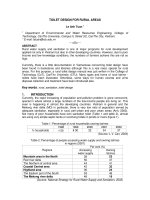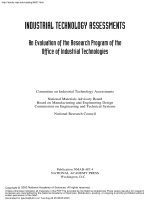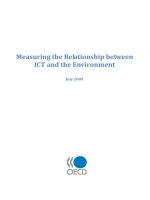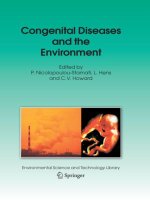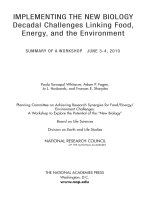Design for the Environment Program Alternatives Assessment Criteria for Hazard Evaluation potx
Bạn đang xem bản rút gọn của tài liệu. Xem và tải ngay bản đầy đủ của tài liệu tại đây (1.21 MB, 50 trang )
Design for the Environment Program Alternatives
Assessment Criteria for Hazard Evaluation
Version 2.0
August 2011
Office of Pollution Prevention & Toxics
U.S. Environmental Protection Agency
U.S. EPA Design for the Environment Program Version 2.0
Alternatives Assessment Criteria for Hazard Evaluation August 2011
- 1 -
To ensure that the Alternatives Assessment Criteria for Hazard Evaluation remain relevant and
useful for distinguishing among chemicals, DfE may update the criteria based on experience
conducting alternatives assessments and on stakeholder input. Additional developments likely
to prompt criteria review, reevaluation, and possible revision include changes to the Globally
Harmonized System (GHS) or EPA programmatic criteria, which are integral to the Alternatives
Assessment Criteria, as well as advances in science, such as those relating to endpoint
characterization or testing methodologies.
U.S. EPA Design for the Environment Program Version 2.0
Alternatives Assessment Criteria for Hazard Evaluation August 2011
- 2 -
Table of Contents
1. Introduction - 4 -
2. General Requirements - 5 -
3. Terms - 6 -
4. Toxicological Criteria - 10 -
4.1. Human Health Effects - 11 -
4.1.1 Acute Mammalian Toxicity - 11 -
4.1.2 Carcinogenicity - 12 -
4.1.3 Mutagenicity/Genotoxicity - 13 -
4.1.4 Reproductive and Developmental Toxicity
(including Developmental Neurotoxicity) - 14 -
4.1.5 Neurotoxicity - 16 -
4.1.6 Repeated Dose Toxicity - 17 -
4.1.7 Respiratory and Skin Sensitization - 18 -
4.1.8 Eye and Skin Irritation/Corrosivity - 20 -
4.1.9 Endocrine Activity - 21 -
4.2. Environmental Toxicity and Fate - 22 -
4.2.1 Aquatic Toxicity - 22 -
4.2.2 Environmental Persistence - 23 -
4.2.3 Bioaccumulation - 24 -
5. Additional Endpoints - 25 -
6. Designating Hazard Using Authoritative Lists - 27 -
6.1 Acute Mammalian Toxicity - 27 -
6.2 Carcinogenicity - 28 -
6.3 Mutagenicity/Genotoxicity - 29 -
6.4 Reproductive and Developmental Toxicity - 29 -
6.5 Repeated Dose Toxicity - 30 -
6.6 Respiratory and Skin Sensitization - 31 -
6.7 Aquatic Toxicity - 32 -
7. Test Methods and Data Interpretation - 33 -
7.1 Acute Mammalian Toxicity – Test Methods - 33 -
7.1.1 Sources for Data Interpretation - 33 -
7.2 Carcinogenicity – Test Methods - 33 -
7.2.1 Sources for Data Interpretation - 33 -
7.3 Mutagenicity/Genotoxicity – Test Methods - 34 -
7.3.1 Sources for Data Interpretation - 34 -
7.4 Reproductive and Developmental Toxicity – Test Methods - 34 -
7.4.1 Sources for Data Interpretation - 35 -
7.5 Neurotoxicity – Test Methods - 35 -
7.5.1 Sources for Data Interpretation - 35 -
7.6 Repeated Dose Toxicity – Test Methods - 36 -
7.6.1 Sources for Data Interpretation - 36 -
7.7 Skin Sensitization – Test Methods - 36 -
7.7.1 Sources for Data Interpretation - 36 -
7.8 Endocrine Activity – Test Methods - 37 -
U.S. EPA Design for the Environment Program Version 2.0
Alternatives Assessment Criteria for Hazard Evaluation August 2011
- 3 -
7.9 Aquatic Toxicity – Test Methods - 37 -
7.9.1 Sources for Data Interpretation - 38 -
7.10 Environmental Persistence – Test Methods - 39 -
7.10.1 Sources for Data Interpretation - 40 -
7.11 Bioaccumulation – Test Methods - 40 -
7.11.1 Sources for Data Interpretation - 40 -
8. Appendix – Alternatives Assessment Criteria Quick Reference - 41 -
9. References - 43 -
U.S. EPA Design for the Environment Program Version 2.0
Alternatives Assessment Criteria for Hazard Evaluation August 2011
- 4 -
1. Introduction
The Design for the Environment (DfE) Program at the U.S. Environmental Protection Agency
developed the Alternatives Assessment Criteria for Hazard Evaluation as a transparent tool for
evaluating and differentiating among chemicals based on their human health and environmental
hazards. The Criteria are applied in of DfE Alternatives Assessments (for a current list of
assessments go to: and can be used by
other organizations.
What are DfE Alternatives Assessments?
DfE Alternatives Assessments are multi-stakeholder partnerships convened to evaluate priority
chemicals and functional alternatives. The goal of an alternatives assessment is to inform
substitution to safer alternatives and reduce the likelihood of unintended consequences that
might result if poorly understood alternatives were chosen. DfE’s expertise and focus is on
chemical hazard; stakeholders assist with the selection of the scope of the alternatives
assessment, help EPA consider economic realities, and identify likely functional alternatives for
evaluation.
What is the basis for the Alternatives Assessment Criteria for Hazard Evaluation?
For most endpoints, the criteria define “High,” “Moderate,” and “Low” concern. While many
hazard classification criteria exist throughout the world, DfE has carefully chosen the criteria that
form the Alternatives Assessment Criteria for Hazard Evaluation with the goal of creating a
rigorous and useful system for differentiating among chemicals based on hazard. Authoritative
sources – the United Nation’s Globally Harmonized System (GHS) for the Classification and
Labeling of Chemicals and U.S. EPA programs – are the basis for these distinctions. The criteria
include endpoints used in the Screening Information Data Set (SIDS) [1], a set of endpoints
internationally agreed upon for characterizing chemical hazards. In assigning a designation of
Low, Moderate, or High concern for hazard, DfE uses the best information available, both
experimental and modeled.
How will the results of the DfE Alternatives Assessments be used?
The results of the alternatives assessments provide EPA and stakeholders with a comprehensive
picture of the hazards of a chemical and its alternatives. The results can be used to place
chemicals on a continuum of relative hazard to inform decision-making on chemical use. To
make the results accessible to a broader audience, other organizations have developed tools that
supplement DfE Alternatives Assessments by weighting hazard endpoints and evaluating trade-
offs. An example of such a tool is the publicly available Green Screen for Safer Chemicals [2]
developed by the non-governmental organization Clean Production Action.
U.S. EPA Design for the Environment Program Version 2.0
Alternatives Assessment Criteria for Hazard Evaluation August 2011
- 5 -
2. General Requirements
2. 1 Data for all relevant routes of exposure will be evaluated. Relevant routes can
include oral, dermal, and inhalation exposures. DfE recognizes that other routes of
exposure are possible, including transplacental transport, lactational transfer, and
intraperitoneal or subcutaneous injection. Data from such exposure routes will be
considered on a case-by-case basis.
2.2. The GHS criteria and data evaluation approach, and EPA risk assessment guidance
will be applied in the review of both no observed adverse effect
levels/concentrations (NOAEL/NOAEC) and lowest observed adverse effect
levels/concentrations (LOAEL/LOAEC). In general, NOAEL/NOAEC and LOAEL/LOAEC
values are preferred over no observed effect levels/concentrations (NOEL/NOEC)
and lowest observed effect levels/concentrations (LOEL/LOEC). When available and
appropriate, the results of benchmark dose modeling will also be considered [3]. In
reviews that include conflicting data, a weight of evidence evaluation aimed at the
protection of human health and environment will inform the hazard designation. All
reviews will include an assessment of potential impacts to vulnerable populations
and life stages.
2.3 Use of existing data should follow the EPA HPV Challenge Program and OECD HPV
Programme data adequacy guidelines:
2.4 When gathering data for evaluation under these criteria, a review of the open
literature including published peer-reviewed studies and government reports as well
as any confidential business information will be conducted.
2.5 In cases where a test species or strain is known to be more or less sensitive to the
test substance, this understanding will be considered in the evaluation of data
against these criteria.
2.6 The degradation or metabolism of a chemical into a by-product which itself is
hazardous, slow to degrade, or bioaccumulative will be considered in the hazard
assessment, where relevant supporting information (such as ADME data) are
available. The purpose of considering degradation products and metabolites is to
gain a better understanding of the overall hazard potential of a chemical.
U.S. EPA Design for the Environment Program Version 2.0
Alternatives Assessment Criteria for Hazard Evaluation August 2011
- 6 -
3. Terms
3.1. Acute aquatic toxicity means the intrinsic property of a substance to be injurious to
an organism in a short-term, aquatic exposure to that substance [4].
3.2. Acute mammalian toxicity refers to those adverse effects occurring following oral or
dermal administration of a single dose of a substance, or multiple doses given within
24 hours, or an inhalation exposure of 4 hours [5].
3.3. ADME: Absorption, discretion, metabolism and excretion.
3.4. Adverse effect: A biochemical change, functional impairment, or pathologic lesion
that affects the performance of the whole organism, or reduces an organism's ability
to respond to an additional environmental challenge [6].
3.5. Attribute: The general property of the chemical that is being evaluated (e.g. acute
mammalian toxicity, persistence).
3.6. The benchmark dose (or concentration) is the dose (or concentration) that is
associated with a specific measure or change of a biological effect. The calculation
of the benchmark dose (BMD) or concentration (BMC) generally represents the
central estimate of the dose or concentration associated with some level of
response above background. The lower limit of an on-side 95% confidence interval
is generally applied to the BMD and BMC [3].
3.7. Bioaccumulation is a process in which a chemical substance is absorbed in an
organism by all routes of exposure as occurs in the natural environment, e.g., dietary
and ambient environment sources. Bioaccumulation is the net result of competing
processes of chemical uptake into the organism at the respiratory surface and from
the diet and chemical elimination from the organism including respiratory exchange,
fecal egestion, metabolic biotransformation of the parent compound and growth
dilution [7].
3.8. Biodegradation is a process in which the destruction of the chemical is
accomplished by the action of a living organism [8].
3.9. A chemical is termed carcinogenic if it is capable of increasing the incidence of
malignant neoplasms, reducing their latency, or increasing their severity or
multiplicity [9].
3.10. A chemical (or compound) is identified by its Chemical Abstract Service (CAS)
number.
U.S. EPA Design for the Environment Program Version 2.0
Alternatives Assessment Criteria for Hazard Evaluation August 2011
- 7 -
3.11. Chronic aquatic toxicity means the intrinsic property of a substance to cause
adverse effects to aquatic organisms during aquatic exposures which are
determined in relation to the life-cycle of the organism [4].
3.12. A compound (or chemical) is identified by its Chemical Abstract Service (CAS)
number.
3.13. Criteria: Endpoints and cutoffs for attribute information. Example: oral acute
mammalian toxicity LD50 must be > 50 mg/kg. Data quality requirements (including
acceptable test methods and information sources) are developed for all criteria.
3.14. Degradation product: Compound resulting from transformation of a chemical
substance through chemical, photochemical, and/or biochemical reactions [10].
3.15. Dermal sensitizer: A substance that will lead to an allergic response following skin
contact [11].
3.16. Developmental toxicity: Adverse effects in the developing organism that may result
from exposure prior to conception (either parent), during prenatal development, or
postnatally to the time of sexual maturation. Adverse developmental effects may be
detected at any point in the lifespan of the organism. The major manifestations of
developmental toxicity include: (1) death of the developing organism, (2) structural
abnormality, (3) altered growth, and (4) functional deficiency [12].
3.17. EC50: The concentration which produces effects in 50% of organisms.
3.18. Endocrine activity refers to a change in endocrine homeostasis caused by a chemical
or other stressor from human activities (e.g., application of pesticides, the discharge
of industrial chemicals to air, land, or water, or the use of synthetic chemicals in
consumer products.)
3.19. An endocrine disruptor is an external agent that interferes in some way with the
role of natural hormones in the body. An agent might disrupt the endocrine system
by affecting any of the various stages of hormone production and activity, such as by
preventing the synthesis of hormones, by directly binding to hormone receptors, or
by interfering with the natural breakdown of hormones [13].
3.20. Estimated concentration three (EC3): Estimated concentration of a test substance
needed to produce a stimulation index of three in the local lymph node assay, a test
used to evaluate dermal sensitization [14].
3.21. Genotoxicity: The more general terms genotoxic and genotoxicity apply to agents or
processes which alter the structure, information content, or segregation of DNA,
including those which cause DNA damage by interfering with normal replication
U.S. EPA Design for the Environment Program Version 2.0
Alternatives Assessment Criteria for Hazard Evaluation August 2011
- 8 -
processes, or which in a non-physiological manner (temporarily) alter its replication.
Genotoxicity test results are usually taken as indicators for mutagenic effects [15].
3.22. An ingredient may be one chemical or a blend of multiple chemicals that are
intentionally added.
3.23. LC50: Median lethal concentration.
3.24. LD50: Median lethal dose.
3.25. LOAEL: Lowest Observed Adverse Effect Level
3.26. LOAEC: Lowest Observed Adverse Effect Concentration
3.27. LOEC: Lowest Observed Effect Concentration
3.28. LOEL: Lowest Observed Effect Level.
3.29. Metabolite: Any substance produced by metabolism or by a metabolic process [16].
3.30. Mutagen: The term mutagenic and mutagen will be used for agents which induce
permanent, transmissible changes in the amount, chemical properties, or structure
of the genetic material. These changes may involve a single gene or gene segment, a
block of genes, parts of chromosomes, or whole chromosomes. Mutagenicity differs
from genotoxicity in that the change in the former case is transmissible to
subsequent cell generations.
3.31. Neurotoxicity: An adverse change in the structure or function of the central and/or
peripheral nervous system following exposure to a chemical, physical, or biological
agent [17].
3.32. NOAEL: No Observed Adverse Effect Level
3.33. NOAEC: No Observed Adverse Effect Concentration
3.34. NOEC: No Observed Effect Concentration
3.35. NOEL: No Observed Effect Level
3.36. Persistence: The length of time the chemical can exist in the environment before
being destroyed (i.e., transformed) by natural processes [18].
3.37. Reproductive toxicity: The occurrence of biologically adverse effects on the
reproductive systems of females or males that may result from exposure to
environmental agents. The toxicity may be expressed as alterations to the female or
U.S. EPA Design for the Environment Program Version 2.0
Alternatives Assessment Criteria for Hazard Evaluation August 2011
- 9 -
male reproductive organs, the related endocrine system, or pregnancy outcomes.
The manifestation of such toxicity may include, but not be limited to, adverse effects
on onset of puberty, gamete production and transport, reproductive cycle normality,
sexual behavior, fertility, gestation, parturition, lactation, developmental toxicity,
premature reproductive senescence, or modifications in other functions that are
dependent on the integrity of the reproductive systems [19].
3.38. Respiratory sensitizer: A substance that will lead to hypersensitivity of the airways
following inhalation of the substance [11].
3.39. Skin corrosion is the production of irreversible damage to the skin; namely, visible
necrosis through the epidermis and into the dermis, following the application of a
test substance for up to 4 hours.
3.40. Skin irritation is the production of reversible damage to the skin following the
application of a test substance for up to 4 hours [20, 21].
3.41. Stimulation Index (SI): A value calculated to assess the skin sensitization potential of
a test substance that is the ratio of the proliferation in treated groups to that in the
concurrent vehicle control group [14].
3.42. Suitable analog: Suitable analogs will be based on a chemically (e.g., based on
chemical structure) or biologically (e.g., based on metabolic breakdown, or likely
mechanistic/mode of action considerations) similar chemical. Guidance for
identifying a suitable analog can be found in OECD Series on Testing and Assessment
No. 80 Guidance on Grouping of Chemicals [22]. The analog used must be
appropriate for the attribute being evaluated.
3.43. Weight-of-evidence: For the purposes of this document, weight-of-evidence refers
to the process of considering the strengths and weaknesses of various pieces of
information in reaching and supporting a conclusion concerning a property of the
substance [23].
U.S. EPA Design for the Environment Program Version 2.0
Alternatives Assessment Criteria for Hazard Evaluation August 2011
- 10 -
4. Toxicological Criteria
Evaluation of chemicals under these criteria will be based on the best available data. In general,
DfE will use data in the following order of preference: 1) measured data on the chemical being
evaluated, 2) measured data from a suitable analog, and 3) estimated data from appropriate
models. EPA experts will evaluate the quality and reliability of both experimental and estimated
data. The majority of measured data are expected to be from laboratory experiments. However,
any available human data will be considered, e.g. Human Repeat Insult Patch Tests. In many
cases, the evaluation of human data will require a qualitative assessment, since the criteria are
primarily based on (non-human) animal studies. Human data may require appropriate review for
ethical treatment of the subjects.
In the absence of measured data on the chemical being evaluated, measured data from a suitable
analog and/or estimated data from computer models will be used. In the event that there are no
suitable analogs, that suitable analogs lack measured data, and the substance, or its analog
cannot be modeled, the hazard endpoint cannot be evaluated and will be designated “no data.”
The links and references in this document are current as of the publication date of these Criteria.
In implementing these criteria, EPA will use the most recent version of each authoritative list, EPA
data interpretation guidance, and test protocol when reviewing a chemical against these criteria.
In the case where a GHS reference in this document is superseded by a more recent version, EPA
may choose to update these criteria to incorporate that newer version. EPA will consider all
sources of developing information, such as the EPA Endocrine Disruptor Screening Program [24]
or enhancements to estimation models such as EPI Suite
TM
[25] that occur over time. For
convenience, a summary of DfE’s Alternatives Assessment Criteria is located in the Appendix (see
Table A1 and Table A2).
U.S. EPA Design for the Environment Program Version 2.0
Alternatives Assessment Criteria for Hazard Evaluation August 2011
- 11 -
4.1. Human Health Effects
4.1.1 Acute Mammalian Toxicity
DfE’s acute mammalian toxicity criteria differentiate compounds based upon a common measure
of short term exposure toxicity, the median lethal dose or concentration (LD
50
or LC
50
), through
oral, dermal, and respiratory routes. Chemical hazard designations will be made based upon the
criteria in Table 1. These values were derived from the GHS criteria [5].
Table 1. Acute Mammalian Toxicity Criteria for Hazard Designation
Acute Mammalian
Toxicity
Very High
High
Moderate
Low
Oral LD50 (mg/kg)
≤ 50
> 50 - 300
> 300 - 2000
> 2000
Dermal LD50 (mg/kg)
≤ 200
> 200 - 1000
> 1000 - 2000
> 2000
Inhalation LC50
(vapor/gas) (mg/L)
≤ 2
> 2 - 10
> 10 – 20
> 20
Inhalation LC50
(dust/mist/fume) (mg/L/day)
≤ 0.5
> 0.5 - 1.0
> 1.0 – 5
> 5
U.S. EPA Design for the Environment Program Version 2.0
Alternatives Assessment Criteria for Hazard Evaluation August 2011
- 12 -
4.1.2 Carcinogenicity
These criteria are designed to indicate whether a compound is known, presumed, or suspected to
increase incidence of cancer, whether available data provide limited or marginal evidence of
carcinogenicity, or whether adequate studies have been conducted to show that a chemical is not
carcinogenic. Carcinogenicity designations will be made according to the criteria in Table 2.
Chemicals known or presumed to be carcinogenic to humans according to the GHS criteria will be
designated as Very High. Chemicals suspected to be carcinogenic to humans according to GHS
criteria will be designated as High. When limited or marginal data on carcinogenicity are present,
a designation of Moderate will be used. The basis for Low concern may be negative
carcinogenicity studies on the chemical being evaluated or robust mechanism-based SAR analysis
which may include (i) negative studies on relevant/suitable analog(s) and/or (ii) combination of
lack of structural alerts and features suggestive of potential carcinogenic activity and negative
supportive, short-term predictive tests.
These criteria mirror the classification approach used by the International Agency for Research on
Cancer (IARC) [26], and incorporate the Globally Harmonized System (GHS) classification scheme
[27]. Authoritative lists can supplement these criteria. Suggested hazard designations for
chemicals classified on authoritative lists appear in Section 6.
Table 2. Carcinogenicity Criteria for Hazard Designation
Carcinogenicity
Very High
High
Moderate
Low
Carcinogenicity
Known or
presumed
human
carcinogen
(equivalent to
GHS Category
1A and 1B)
Suspected
human
carcinogen
(equivalent to
GHS Category 2)
Limited or
marginal evidence
of carcinogenicity
in animals (and
inadequate
evidence in
humans)
Negative studies
or robust
mechanism-
based SAR (as
described above)
U.S. EPA Design for the Environment Program Version 2.0
Alternatives Assessment Criteria for Hazard Evaluation August 2011
- 13 -
4.1.3 Mutagenicity/Genotoxicity
The Mutagenicity/Genotoxicity criteria classify chemicals based on evidence that heritable
mutations are known to occur in the germ cells of humans (Very High), heritable mutations may
occur in the germ cells of humans or that evidence of mutagenicity is demonstrated in vitro and
in vivo (High), or evidence of mutagenicity is demonstrated in vitro or in vivo (Moderate). A Low
hazard designation will be assigned for chemicals that are negative for chromosomal aberrations
and gene mutations, or have no structural alerts. The criteria are taken from the GHS [15] and
supplemented with considerations for mutagenicity and genotoxicity in cells other than germ
cells (Table 3). As with all endpoints, a weight-of-evidence approach is applied to available data.
Authoritative lists can supplement these criteria. Suggested hazard designations for chemicals
classified on authoritative lists appear in Section 6.
Table 3. Mutagenicity/Genotoxicity Criteria for Hazard Designations
Mutagenicity/
Genotoxicity
Very High
High
Moderate
Low
Germ cell mutagenicity
GHS Category 1A or
1B: Substances
known to induce
heritable mutations
or to be regarded as
if they induce
heritable mutations
in the germ cells of
humans
GHS Category 2:
Substances which
cause concern for
humans owing to
the possibility that
they may induce
heritable
mutations in the
germ cells of
humans
OR
Evidence of
mutagenicity
supported by
positive results
in in vitro OR in
vivo somatic
cells of humans
or animals
Negative for
chromosomal
aberrations
and gene
mutations, or
no structural
alerts.
Mutagenicity and
genotoxicity in somatic
cells
Evidence of
mutagenicity
supported by
positive results in
in vitro AND in
vivo somatic cells
and/or germ cells
of humans or
animals
U.S. EPA Design for the Environment Program Version 2.0
Alternatives Assessment Criteria for Hazard Evaluation August 2011
- 14 -
4.1.4 Reproductive and Developmental Toxicity (including Developmental
Neurotoxicity)
Reproductive toxicity:
DfE’s reproductive toxicity criteria classify compounds based on the potential to cause adverse
effects on reproductive capacity. Reproductive toxicity may be expressed as alterations to the
female or male reproductive organs, the related endocrine system, or pregnancy outcomes. The
manifestation of such toxicity may include, but not be limited to, adverse effects on onset of
puberty, gamete production and transport, reproductive cycle normality, sexual behavior,
fertility, gestation, parturition, lactation, developmental toxicity, premature reproductive
senescence, or modifications in other functions that are dependent on the integrity of the
reproductive systems. [19]
Developmental toxicity (including Developmental Neurotoxicity):
DfE’s developmental toxicity criteria classify compounds based on the potential to cause adverse
effects on development of offspring. Developmental toxicity includes adverse effects in the
developing organism that may result from exposure prior to conception (either parent), during
prenatal development, or postnatally to the time of sexual maturation. Adverse developmental
effects may be detected at any point in the lifespan of the organism. The major manifestations of
developmental toxicity include: (1) death of the developing organism, (2) structural abnormality,
(3) altered growth, and (4) functional deficiency [12]. Effects associated with developmental
neurotoxicity include neurobehavioral and neuropathological assessments of rat offspring
following in utero and postnatal exposure to the test chemical.
Table 4. Reproductive and Developmental Toxicity Criteria for Hazard Designations
Reproductive and
Developmental Toxicity
High
Moderate
Low
Very Low
Oral (mg/kg/day)
< 50
50 – 250
> 250-1000
> 1000
Dermal (mg/kg/day)
< 100
100 – 500
> 500-2000
> 2000
Inhalation
(vapor/gas) (mg/L/day)
< 1
1 - 2.5
> 2.5-20
> 20
Inhalation
(dust/mist/fume) (mg/L/day)
< 0.1
0.1 - 0.5
> 0.5-5
> 5
Using all available information, two hazard designations, one for reproductive toxicity and one for
developmental toxicity will be made. Parental (reproductive) and offspring (developmental)
exposure to a substance through oral, dermal and respiratory routes will be evaluated using the
criteria in Table 4. In general, the NOAEL and LOAEL will be considered as a basis for evaluation.
The criteria were derived from the US EPA’s Office of Pollution Prevention & Toxics criteria for
HPV chemical categorization [28], and the EU REACH criteria for Annex IV. (Annex IV includes
criteria to identify chemicals that are exempted from the registration, evaluation, and
downstream user provisions of REACH because they are of minimum risk based on their intrinsic
properties [29].)
U.S. EPA Design for the Environment Program Version 2.0
Alternatives Assessment Criteria for Hazard Evaluation August 2011
- 15 -
Authoritative lists can supplement these criteria. Suggested hazard designations for chemicals
classified on authoritative lists appear in Section 6.
U.S. EPA Design for the Environment Program Version 2.0
Alternatives Assessment Criteria for Hazard Evaluation August 2011
- 16 -
4.1.5 Neurotoxicity
DfE’s neurotoxicity criteria will classify compounds based upon observed neurotoxic effects
through oral, dermal, and respiratory exposure routes. Neurotoxic effects can be observed at
multiple levels of organization within the nervous system, including neurochemical, anatomical,
or behavioral, and across life stages. In general, NOAEL and LOAEL values will be considered as
the basis for evaluation. Chemical hazard designations will be made based on the criteria in Table
5 which were derived from GHS criteria for Specific Target Organ Toxicity Repeated Exposure
[30].
The dose values in Table 5 are to be applied to 90-day repeated dose studies. Dose values are
tripled for chemicals evaluated in 28-day studies and similarly modified for studies of longer
durations.
Table 5. Neurotoxicity Criteria for Hazard Designations
Neurotoxicity
High
Moderate
Low
Oral (mg/kg-bw/day)
90-day (13 weeks)
40-50 days
28-days (4 weeks)
<10
< 20
<30
10 – 100
20 – 200
30 – 300
>100
> 200
> 300
Dermal (mg/kg-bw/day)
90-day (13 weeks)
40-50 days
28-days (4 weeks)
<20
<40
<60
20 – 200
40 – 400
60 – 600
>200
>400
>600
Inhalation(vapor/gas) (mg/L/6h/day) 90-day
(13 weeks)
40-50 days
28-days (4 weeks)
<0.2
<0.4
<0.6
0.2 – 1.0
0.4 – 2.0
0.6 – 3.0
>1.0
>2.0
>3.0
Inhalation(dust/mist/fume) (mg/L/6h/day)
90-day (13 weeks)
40-50 days
28-days (4 weeks)
<0.02
<0.04
<0.06
0.02 – 0.2
0.04 – 0.4
0.06 – 0.6
>0.2
>0.4
>0.6
U.S. EPA Design for the Environment Program Version 2.0
Alternatives Assessment Criteria for Hazard Evaluation August 2011
- 17 -
4.1.6 Repeated Dose Toxicity
Chronic exposure will be evaluated with the results from repeated dose toxicity testing through
oral, dermal, and respiratory routes. Repeated dose test methods are designed to be broadly
encompassing, capturing effects on any/all major organ systems. In general, the NOAEL and
LOAEL will be considered as a basis for evaluation. Chemical hazard designations will be made
based upon the criteria in Table 6 which are taken from the GHS criteria for Specific Target Organ
Toxicity Repeated Exposure [30], and mirror the US EPA’s Office of Pollution Prevention & Toxics
criteria for HPV chemical categorization [28].
The dose values in Table 6 are to be applied to 90-day repeated dose studies. Dose values are
tripled for chemicals evaluated in 28-day studies and similarly modified for studies of longer
durations.
Authoritative lists can supplement these criteria. Suggested hazard designations for chemicals
classified on authoritative lists appear in Section 6.
Table 6. Repeated Dose Toxicity Criteria for Hazard Designations
Repeated Dose Toxicity
High
Moderate
Low
Oral (mg/kg-bw/day)
90-day (13 weeks)
40-50 days
28-days (4 weeks)
<10
< 20
<30
10 – 100
20 – 200
30 – 300
>100
> 200
> 300
Dermal (mg/kg-bw/day)
90-day (13 weeks)
40-50 days
28-days (4 weeks)
<20
<40
<60
20 – 200
40 – 400
60 – 600
>200
>400
>600
Inhalation(vapor/gas) (mg/L/6hrs/day) 90-day
(13 weeks)
40-50 days
28-days (4 weeks)
<0.2
<0.4
<0.6
0.2 – 1.0
0.4 – 2.0
0.6 – 3.0
>1.0
>2.0
>3.0
Inhalation(dust/mist/fume) (mg/L/6hrs/day)
90-day (13 weeks)
40-50 days
28-days (4 weeks)
<0.02
<0.04
<0.06
0.02 – 0.2
0.04 – 0.4
0.06 – 0.6
>0.2
>0.4
>0.6
U.S. EPA Design for the Environment Program Version 2.0
Alternatives Assessment Criteria for Hazard Evaluation August 2011
- 18 -
4.1.7 Respiratory and Skin Sensitization
Evidence of whether exposure to a chemical can elicit an allergic response upon contact will be
evaluated in DfE’s sensitization criteria. Both dermal and respiratory sensitization will be
considered. For skin sensitization and respiratory sensitization, chemical hazard designations
incorporate the GHS criteria [11] as described in Table 7. Further details about the GHS criteria
for categorizing chemicals as Category 1A or 1B skin sensitizers is given in Tables 8 and 9
respectively. For respiratory sensitization, a designation of no data is possible.
Authoritative lists can supplement these criteria. Suggested hazard designations for chemicals
classified on authoritative lists appear in Section 6.
Table 7. Sensitization Criteria for Hazard Designations
Sensitization
High
Moderate
Low
Skin Sensitization
High frequency of
sensitization in
humans and/or high
potency in animals
(GHS Category 1A)
Low to moderate
frequency of
sensitization in human
and/or low to moderate
potency in animals (GHS
Category 1B)
Adequate data
available and
not GHS
Category 1A or
1B
Respiratory Sensitization
Occurrence in humans
or evidence of
sensitization in
humans based on
animal or other tests
(equivalent to GHS
Category 1A and 1B)
Limited evidence
including the presence of
structural alerts
Adequate data
available
indicating lack of
respiratory
sensitization
Table 8. GHS Category 1A Skin Sensitization Criteria Used for High Hazard Designation
Assay
GHS Category 1A Criteria
Local lymph node assay
EC3 value ≤ 2%
Guinea pig maximization
test
≥ 30% responding at ≤ 0.1% intradermal induction dose or
≥ 60% responding at > 0.1% to ≤ 1% intradermal induction dose
Buehler assay
≥ 15% responding at ≤ 0.2% topical induction dose or
≥ 60% responding at > 0.2% to ≤ 20% topical induction dose
U.S. EPA Design for the Environment Program Version 2.0
Alternatives Assessment Criteria for Hazard Evaluation August 2011
- 19 -
Table 9. GHS Category 1B Skin Sensitization Criteria Used for Moderate Hazard Designation
Assay
GHS Category 1B Criteria
Local lymph node assay
EC3 value > 2%
Guinea pig maximization
test
≥ 30% to < 60% responding at > 0.1% to ≤ 1% intradermal induction dose or
≥ 30% responding at > 1% dermal induction dose
Buehler assay
≥ 15% to < 60%responding at > 0.2% to ≤ 20% topical induction dose or
≥ 15% responding at > 20% topical induction dose
U.S. EPA Design for the Environment Program Version 2.0
Alternatives Assessment Criteria for Hazard Evaluation August 2011
- 20 -
4.1.8 Eye and Skin Irritation/Corrosivity
Data on a chemical’s ability to cause eye and skin irritation/corrosivity will be reviewed under
these criteria. Hazard designations will be made based upon the criteria in Table 10. These
criteria were derived from the Office of Pesticide Programs Acute Toxicity Categories [31].
Table 10. Irritation Criteria for Hazard Designations
Irritation/Corrosivity
Very
High
High
Moderate
Low
Very
Low
Eye Irritation/Corrosivity
Irritation
persists for
> 21 days
or corrosive
Clearing in
8-21 days,
severely
irritating
Clearing in 7
days or less,
moderately
irritating
Clearing in
less than
24 hrs,
mildly
irritating
Not
irritating
Skin Irritation/Corrosivity
Corrosive
Severe
irritation
at 72
hours
Moderate
irritation at 72
hours
Mild or
slight
irritation
at 72 hours
Not
irritating
U.S. EPA Design for the Environment Program Version 2.0
Alternatives Assessment Criteria for Hazard Evaluation August 2011
- 21 -
4.1.9 Endocrine Activity
EPA will evaluate endocrine activity rather than characterize hazard in terms of “endocrine
disruption”. Evidence of a chemical having endocrine activity will be summarized in a narrative.
A) Data Resources
Endocrine activity can be defined as a change in endocrine homeostasis caused by a chemical
or other stressor from human activities (e.g., application of pesticides, the discharge of
industrial chemicals to air, land, or water, or the use of synthetic chemicals in consumer
products.). Data that will be considered include:
In vitro data such as hormone receptor binding assays or ex vivo assays
In vivo data from studies of intact animals or wildlife (including aquatic organisms)
Ethically conducted human studies
In vivo short term exposures or altered (e.g., ovariectomized) animal models
Structural similarity to known endocrine active substances using SAR tools such as AIM,
QSAR, etc.
Additional information gleaned from studies that are indicative of a chemical’s endocrine
system interactions, such as changes in hormone profiles or reproductive organ weights.
B) Criteria
Available data for each chemical will be evaluated for evidence of the presence of endocrine
activity.
If there are no data available to evaluate this endpoint, endocrine activity is unknown,
untested and would be marked with a “ND” indicating the absence of information. (No
Data)
If data show evidence of endocrine activity then the chemical will be designated as
potentially endocrine active, while noting caveats and limitations.
If data conclude no evidence of activity (no binding, perturbation, or evidence of
endocrine-related adverse effects) then the chemical will be designated as having no
evidence of endocrine activity, noting caveats and limitations.
In consultation with EPA toxicologists and risk assessors, DfE will provide a summary statement of
the available data, including the presence of equivocal or conflicting data and any limitations to
the available data. The level of confidence in the assessment will be noted.
U.S. EPA Design for the Environment Program Version 2.0
Alternatives Assessment Criteria for Hazard Evaluation August 2011
- 22 -
4.2. Environmental Toxicity and Fate
4.2.1 Aquatic Toxicity
Chemicals will be assigned hazard designations based on either the LC50 or EC50 values for acute
aquatic toxicity, and the no or lowest observed effect concentration (NOEC and LOEC,
respectively) for chronic aquatic toxicity. The criteria used for making chemical hazard
designations are shown in Table 11. These values were derived from the GHS criteria [4], EPA
Office of Pollution Prevention and Toxics’ (OPPT) New Chemicals Program [32] and OPPT’s criteria
for HPV chemical categorization [28].
Table 11. Aquatic Toxicity Criteria for Hazard Designations
Aquatic Toxicity
Very High
High
Moderate
Low
Acute Aquatic Toxicity
(LC50 or EC50) (mg/L)
< 1.0
1 - 10
> 10 - 100
> 100
Chronic Aquatic Toxicity
(NOEC or LOEC) (mg/L)
< 0.1
0.1 - 1
> 1 - 10
> 10
U.S. EPA Design for the Environment Program Version 2.0
Alternatives Assessment Criteria for Hazard Evaluation August 2011
- 23 -
4.2.2 Environmental Persistence
Persistence designations will be based on ultimate degradation. Degradation as the result of
microbial action, hydrolysis, photolysis, and other relevant mechanisms will be considered. In the
absence of data on ultimate degradation, DfE will evaluate data on primary degradation of the
compound and consider the potential for persistent degradation products. Environmental
monitoring data may modify how a persistence designation is determined. If Ready
Biodegradability test data are available but the chemical did not pass, the chemical is evaluated
based on measured data for half-life (e.g., simulation tests).
In the absence of measured data on the substance of interest, DfE will evaluate data for suitable
analogs and estimated values from models such as EPI Suite or SPARC [33]. Persistence
designations will be made based upon the criteria in Table 12. These values were derived from
OPPT’s New Chemicals Program and the DfE Master Criteria, and reflect OPPT policy on PBTs [18,
34, 35]. For persistence in air, designations of High, Moderate, and Low will not be used.
Instead, a qualitative assessment of available data will be prepared.
Table 12. Criteria for Persistence Designations
Environmental
Persistence
Very
High
High
Moderate
Low
Very Low
Persistence in water,
soil or sediment
Half-life >
180 days
or
recalcitrant
Half life
of 60 –
180 days
Half-life < 60
but ≥ 16
days
Half-life < 16
days OR passes
Ready
Biodegradability
test not
including the
10-day
window.*
Passes Ready
Biodegradability
test with 10-day
window.*
Persistence in air
For this endpoint, High/Moderate/Low etc. characterizations will not apply.
A qualitative assessment of available data will be prepared.
* See Ready Biodegradation test criteria [36-38].
Application of Ready Tests to Mixtures of Structurally Similar Chemicals:
According to OECD guidance, ready biodegradability tests are usually intended for pure
chemicals. The ready biodegradability tests can be applied to “mixtures of structurally similar
chemicals like oils and surface-active substances (surfactants)” [39]. OECD guidance states that
“if a test on the mixture is performed and it is anticipated that a sequential biodegradation of the
individual structures is taking place, then the 10-day window should not be applied to interpret
the results of the test.” EPA follows OECD recommendations on the interpretation of ready
biodegradability for structurally similar mixtures.
U.S. EPA Design for the Environment Program Version 2.0
Alternatives Assessment Criteria for Hazard Evaluation August 2011
- 24 -
4.2.3 Bioaccumulation
Data on the capacity for a compound to bioaccumulate will be evaluated. Environmental
monitoring data will be considered when available. The criteria used to make bioaccumulation
designations are shown in Table 13. These criteria were derived from OPPT’s New Chemicals
Program [34], and Arnot & Gobas 2006 [7].
Table 13. Criteria for Bioaccumulation Designations
Bioaccumulation
Very High
High
Moderate
Low
BAF/BCF
> 5,000
5,000 – 1,000
<1,000 – 100
< 100
Log BAF/BCF
>3.7
3.7 – 3
<3 – 2
< 2
When experimental BAF or BCF data are available:
1) If a measured log BAF or BCF is available and the value >2, apply the bioaccumulation
criteria in Table 13.
2) If there are measured log BCF <2, consider application of the criteria on a case-by-case
basis. For example, if there is a single measured log BCF <2, use the upper trophic BAF with
metabolism from the BCFBAF model in EPI Suite. If there are several measured values
which all support a designation of low bioaccumulation potential, then the chemical will be
designated as such.
3) If there are measured log BAF < 2, then the chemical is designated as a Low for
bioaccumulation.
When experimental BAF or BCF data are not available:
1) If there are no measured BCF or BAF values, consider the octanol-water (Kow) and octanol-
air (Koa) partition coefficients. If a chemical has log Kow <2 or log Koa <5, it is given a low
designation for bioaccumulation [7]; an estimated BAF or BCF is not needed. If no
measured Kow and Koa values are available, they can be estimated from the EPI Suite
models KOWWIN and KOAWIN or other models that may be available for these endpoints
(e.g. SPARC).
2) If bioaccumulation is not Low after evaluating log Kow and log Koa as defined above, and
there are no experimental bioaccumulation data, use estimated values (such as upper
trophic BAF with metabolism from EPI Suite’s BCFBAF model) and apply the
bioaccumulation criteria in Table 13.

